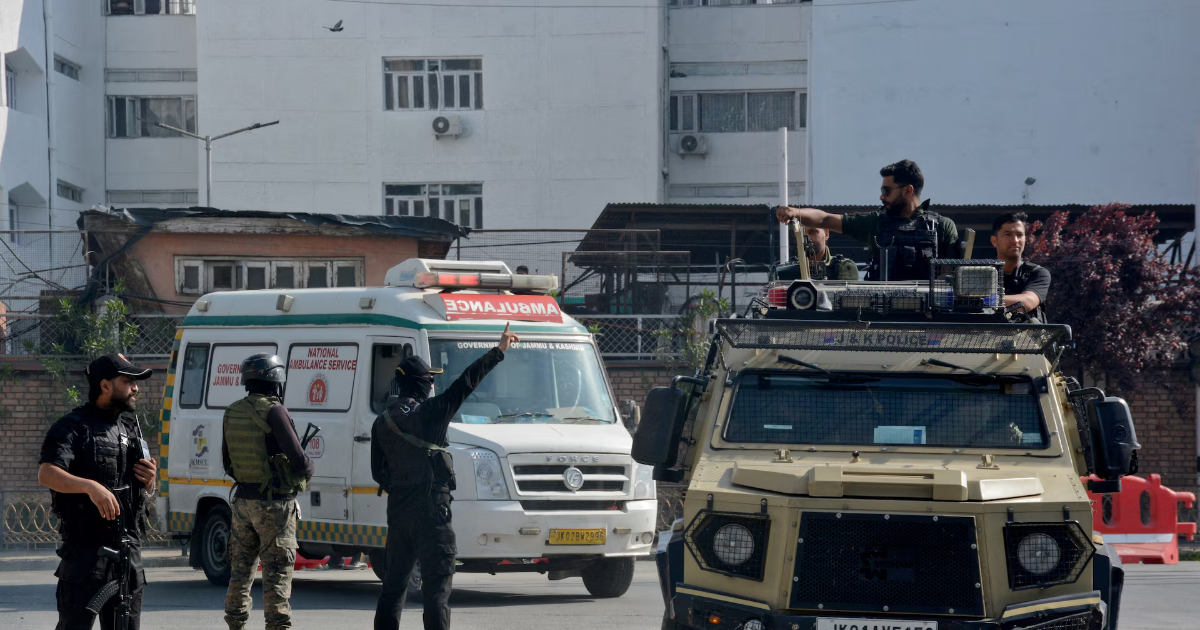SRINAGAR, India, April 23 (Reuters) – Twenty-six people were killed and 17 were injured when suspected militants opened fire at tourists in India’s Jammu and Kashmir territory, police said on Wednesday, the worst such attack in the country in nearly two decades.
The attack took place on Tuesday in a meadow in the Pahalgam area of the scenic, Himalayan federal territory and the dead included 25 Indians and one Nepalese national, police said.
Sign up here.
It was the worst attack on civilians in India since the 2008 Mumbai shootings, and shattered the relative calm in Kashmir, where tourism has boomed as an anti-India insurgency
, opens new tab has waned in recent years.
Prime Minister Narendra Modi cut short his two-day visit to Saudi Arabia and returned to New Delhi on Wednesday morning. Finance Minister Nirmala Sitharaman was also cutting short her visit to the United States and Peru “to be with our people in this difficult and tragic time”, her ministry said.
Modi held a meeting with the national security adviser, the foreign minister and other senior officials at the airport and a special security cabinet meeting had been called for 1230 GMT, a defence ministry official said.
The attack is seen as a setback to what Modi and his Hindu nationalist Bharatiya Janata Party have projected as a major achievement in revoking the semi-autonomous status Jammu and Kashmir enjoyed and bringing peace and development to the long-troubled Muslim-majority region.
A little-known militant group, the “Kashmir Resistance,” claimed responsibility for the attack in a social media message. It expressed discontent that more than 85,000 “outsiders” had been settled in the region, spurring a “demographic change”.
In a fresh statement on Wednesday, the group said that the “individuals targeted were not ordinary tourists; instead, they were linked to and affiliated with Indian security agencies”.
“It was not a typical tourist group but rather an undercover agency tasked with research,” it said and added that the attack should “serve as a wake-up call not only for Delhi but also for those who support Delhi’s questionable strategies”.
Hundreds of security forces rushed to the Pahalgam area soon after the attack and a massive combing operation was launched in the forests there, two security sources told Reuters. About 100 people suspected to have been militant sympathisers in the past were called to police stations and questioned, they added.
Indian security agencies say Kashmir Resistance is a front for Pakistan-based militant organisations such as Lashkar-e-Taiba and Hizbul Mujahideen. Pakistan has said it only provides moral and diplomatic support to the insurgency in Kashmir.
“We are concerned at the loss of tourists’ lives,” Pakistani foreign ministry spokesman Shafqat Ali Khan said in a statement. “We extend our condolences to the near ones of the deceased and wish the injured a speedy recovery.”
Chart shows the number of tourists visiting Kashmir region annually between 2015 and 2024. There was as surge in the footfall in the past three years, peaking at 3.5 million in 2024.
KASHMIR SHUTDOWN
On Wednesday, over a dozen local organisations called for a shutdown in the federal territory to protest against the attack on tourists, whose rising numbers have helped the local economy.
Many schools also suspended classes for the day in protest.
Airlines were operating extra flights from Srinagar, the summer capital of the territory, as visitors were rushing out of the region, officials said.
The main highway connecting Srinagar to the rest of the country had been damaged by heavy rain and was shut for repairs, pushing up demand for flights, they said.
Television visuals showed tourists carrying their bags to taxis and filing out of a hotel in Srinagar.
“How can we continue our trip in such a situation?” Sameer Bhardwaj, a tourist from New Delhi, told news agency ANI. “We need to prioritise our safety. We can only travel if our minds are relaxed but everyone is tense here. So, we cannot continue to travel.”
Aviation Minister Rammohan Naidu Kinjarapu’s office said four special flights from Srinagar – two to Delhi and two to Mumbai – have been arranged, with additional flights kept on standby to cater to further evacuation needs.
“Naidu also held an urgent meeting with all airline operators and…directed (them) to maintain regular fare levels, ensuring that no passenger is burdened during this sensitive time,” it said in a statement.
Chart shows the number of civilians and security forces killed in the conflict in Jammu and Kashmir, India, from 2000 to 2024.
Militant violence has afflicted Kashmir, claimed in full but ruled in part by both Hindu-majority India and Islamic Pakistan, since the anti-Indian insurgency began in 1989. Tens of thousands of people have been killed, although violence has tapered off in recent years.
India revoked Kashmir’s special status in 2019, splitting the state into two federally administered territories – Jammu and Kashmir, and Ladakh. The move allowed local authorities to issue domicile rights to outsiders, allowing them to get jobs and buy land in the territory.
That led to a deterioration of ties with Pakistan, which also claims the region. The dispute has spurred bitter animosity and military conflict between the nuclear-armed neighbours.
Attacks targeting tourists in Kashmir have been rare. The last deadly incident took place in June 2024 when at least nine people were killed and 33 injured after a militant attack caused a bus carrying Hindu pilgrims to plunge into a deep gorge.
Reporting by Fayaz Bukhari; Additional reporting by Nigam Prusty in New Delhi, Sudipto Ganguly and Shilpa Jamkhandikar in Mumbai, and Charlotte Greenfield in Islamabad; Writing by YP Rajesh; Editing by Muralikumar Anantharaman and Raju Gopalakrishnan
Our Standards: The Thomson Reuters Trust Principles.
